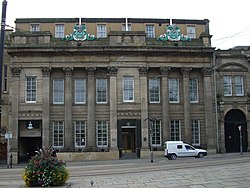Cutlers' Hall
| Cutlers' Hall | |
|
Yorkshire | |
|---|---|
 Cutlers' Hall | |
| Location | |
| Grid reference: | SK35388741 |
| Location: | 53°22’57"N, 1°28’10"W |
| City: | Sheffield |
| History | |
| Address: | Church Street |
| Built 1832 | |
| For: | The Company of Cutlers in Hallamshire by Samuel Worth and Benjamin Broomhead Taylor |
| Information | |
| Owned by: | The Company of Cutlers in Hallamshire |
| Website: | www.cutlershall.co.uk |
Cutlers' Hall stands on Church Street, opposite Sheffield Cathedral in the heart of Sheffield, in the West Riding of Yorkshire. It is the headquarters of the Company of Cutlers in Hallamshire, for whom it was built.
The hall is was built for the Company in 1832 and is a Grade II* listed building.
History
The Cutlers' Hall was built in 1832 by Samuel Worth and Benjamin Broomhead Taylor at a cost of £6,500. It was extended in 1865–7 by Flockton & Abbott, and again in 1888 by J. B. Mitchel-Withers.[1]
This is Sheffield's third Cutlers' Hall; the previous buildings, which were built in the same location, were built in 1638 and in 1725. Before the Stuart-period hall of 1638, the cutlers met in rented accommodation, and tradition holds that this was a public house on Fargate, although there is no documentary evidence to back this up. The first Cutlers' Hall, a stone building with a slated roof, was built in 1638 at a cost of £155 15s 10d, of which £57 18s 4d was raised by subscription. The building was quickly found to be inadequate, having to be repaired on many occasions and in 1725, a new Cutlers' Hall was erected on the same site at a cost of £442. It was an attractive, narrow Georgian three storeyed building with a string course cornice.
Towards the end of the 18th century the Cutlers' Hall was used as an overspill court room as the Town Hall across Church Street could not cope with the increasing number of crimes being tried in the growing city.[2]
The Hall's front is of the Corinthian order. Behind the classical façade is an intricate series of rooms which reach back almost as far as Fargate. There is a selection of old Hallamshire knives on show inside the hall, some of which go back to the Elizabethan era. Many of the knives were discovered by Thames mudlarks in the tidal mud of the River Thames in London.[3] Also on display is the Norfolk Knife, a very large pocket knife with 75 blades which was made by Joseph Rodgers and Sons at their Norfolk Street Works in Sheffield for the Crystal Palace Great Exhibition of 1851.[4][5]
Today, the building is used for many of the grandest events in the city's civic and commercial life, for instance the annual Cutlers' Feast which became an annual event in 1648. As of 2008 there have been 372 Cutlers' Feasts with breaks only for the World Wars and a cancellation in 1921.[6]
The banks neighbouring the Cutlers' Hall are in a similar style. One was designed by Samuel Worth in 1838, the other was completed in 1867.
The Cutlers' Hall is maintained by the Cutlers' Hall Preservation Trust, a registered charity.[7]
Outside links
| ("Wikimedia Commons" has material about Cutlers' Hall) |
References
- ↑ "Pevsner Architectural Guides - Sheffield", Ruth Harman & John Minnis, ISBN 0-300-10585-1
- ↑ Walton, Mary: 'Sheffield: Its Story and its Achievements" ISBN 0-904293-19-X
- ↑ National Geographic. – Thames Mudlarks.
- ↑ Vickers, J. Edward: 'A Popular History of Sheffield' ISBN 0-906787-04-1
- ↑ Joseph Rodgers: Egginton Group
- ↑ Clyde Binfield and David Hey: 'Mesters to Masters' (Oxford University Press) ISBN 0-19-828997-9
- ↑ The Cutlers' Hall Preservation Trust Limited - Registered Charity no. 513038 at the Charity Commission